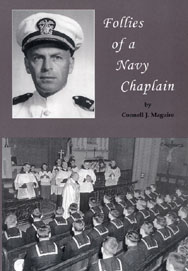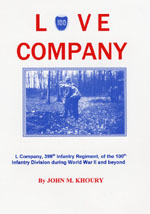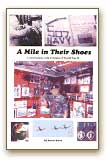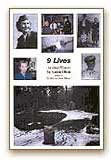Marion Hess served as president of the 124th Infantry Regimental Association. She was a frequent visitor to Tank Books. Marion passed away in 2002.
© 2011, 124th Infantry Regimental Association
After 50 years, the jungle has reclaimed jurisdiction of the battle site. But for the soldiers who fought there, the area will forever be known as Colgan Woods. In a patch of rain forest in the central area of Mindanao, the Philippine Islands, Catholic Chaplain (Capt.) Aquinas T. Colgan, beloved by the men of the 124th Infantry Regiment, 31st (Dixie) Division, sacrificed his life in a heroic attempt to save the life of a wounded medic during a six-day battle against fanatical Japanese resistance.
Father Colgan's exploits are the story of a man who served God and his men in the most difficult of wartime conditions, yet who brought a sense of humanity to a very savage world.
Standing only 5-feet-8-inches tall, Father Colgan appeared small in stature in his wire-rim glasses and steel helmet. Yet through his actions and example, he became larger than life to all who met him.
Born in Chicago’s tough south side, Father Colgan spent the first five years after his ordination into the Carmelite Order in 1936 teaching Spanish and English at Mt. Carmel High School. Endowed with street-smart wit and humor, he displayed a spiritual magic as he worked with the oppressed, poor and friendless Mexican workers. A licensed pilot, he used his skills to give pre-flight training to young men at a local aeronautical school.
After the attack on Pearl Harbor in December 1941, Father Colgan immediately applied for permission to enter the service. Two of his three brothers would also serve, one in the Marine Corps and the other in the Army with Merrill’s Marauders in Burma.
His superior, the Rev. Ambrose Casey, O. Carm., later said that, "Never have I seen any man wish for anything in his life as much as Father Aquinas wished to be commissioned a chaplain in the United States Army!"
It was his charm and ability to poke fun at life that would endear him to the rugged Southerners of the "Dixie" Division who would become his new flock. But Father Colgan had a serious side he did not often show. He once told a fellow seminarian, "Every man is a thought of God and had his particular destiny to fill." Father Colgan was about to embark on a journey that would lead to his destiny and alter the lives of his men forever.
After completing training at the Harvard University Chaplain School, Father Colgan was assigned to the 31st Division, located at Camp Pickett, Va., for final training and staging in preparation for embarkation overseas.
Chaplain Colgan trained with the troops during mountain maneuvers in West Virginia and amphibious training in Norfolk, Va. In a letter home, Staff Sgt. Charles T. Morgan wrote, "No matter how long the hikes, or how tired and disgusted the men were, he always had a story that kept them smiling. Whatever the men had to do, he did it too, and made a joke of it."
When the division landed in Dobadura, New Guinea, in March of 1944, Father Colgan marched with the men in jungle training and day and night practice of amphibious landings. Despite the extreme conditions, he managed to hold regular religious services.
In July 1944, the 124th Infantry Regiment. was ordered to Aitape, New Guinea, to reinforce the 32nd Division against an anticipated counterattack by elements of the Japanese 18th Army. In its first combat engagement, the soldiers of the 124th engaged in fierce fighting in dense jungle for more than a month, from July 13 to August 15. Daily rain and fog hindered supply air drops and the wounded were carried as litter cases, as it was impossible to evacuate them. Comforting the men, he would tell them, "Every night’s a New Year’s Eve; every day’s a payday."
Chaplain Colgan was always up on the line chatting with the men, noted Dr. Thomas Deas, regimental surgeon with the 124th Medical Detachment. "He talked all of the time," said Deas.
Writing in the 1st Battalion Unit Journal, Capt. Edward S. Becker, S-3, noted, "Chaplain Colgan should be commended for the part he played in keeping up the morale and spirits of the men who were in an exhausted state. There was never an opportunity that passed when ‘Chappie’ didn’t insist on holding a service. He was here today, at 3rd Battalion the next, then Regimental Headquarters, the 149th Field Artillery and next at 2nd Battalion. This sounds like his normal duties, but this could only be said by one who did not know that the distances between units were sometimes five miles apart and in those days we walked. His jokes and cheerfulness smoothed many men's brows."
Father Colgan wrote often to his fellow priests back in Chicago. In his letters he described the challenges faced in conducting services in the jungle with makeshift altars of ration boxes and always in fear of snipers.
The 124th Infantry Regiment sustained 380 casualties at Aitape. Protestant Chaplain Roger Melton and Chaplain Colgan buried 87 men killed in action.
Eight days after the conclusion of the Aitape action, Field Order No. 1, Tradewind Task Force, was received on Aug. 23 outlining plans for the invasion of Morotai, Netherlands East Indies. The 124th Regiment rejoined the 31st Division and on Sept. 11 sailed on the Australian troop ship S.S. Knimbala to join a 150-ship convoy.
The three-day trip was uneventful and as was common, the men spent some time below decks playing cards and shooting craps. It’s been told that Chaplain Colgan occasionally joined in the games and when lady luck was not at his side, he would retire to a corner, take out his Rosary and pray before returning to the game.
With the objective of establishing airfields and communications bases in support of the eventual liberation of the Philippines, the task force secured Morotai and in November the Air Force and Navy arrived to begin construction.
The division settled into a routine of mountain patrols and securing the surrounding islands. During this time Chaplain Colgan had two thatched chapels built on Morotai, and in addition to administering to his own troops, made many visits to Navy ships which did not have chaplains aboard. In his letters home, he wrote of conducting three-hour masses due to the constant air raids interrupting the services.
On the panel beneath the windshield of Father Colgan's jeep were painted the words "Chicago Streetfighter." Many of the men belonged to the mythical Chicago Streetfighters Club, which he presided over. All club members were issued a card inscribed with names of the Chicago mayor, police commissioner and the superintendant of the House of Corrections. The card entitled the holder to a daylight stopover in Chicago and was signed by Aquinas T. Colgan, Supreme Brawler. Even today, many veterans still carry their cards as treasured possessions.
Life on Morotai had, by this time, settled down to semi-garrison living. Enemy ground activity practically ceased. Father Colgan was never one to pass up an occasion to lighten the spirits of the men. In March, when St. Patrick’s Day arrived, he felt that a celebration was in order. Although sacramental wine was plentiful, whiskey was not. To remedy the situation, Father Colgan talked a member of the Medical Detachment into providing a canteen full of 190 proof ethyl alcohol, enough to make three quarters of a gallon of 80 proof liquor. St. Patrick’s Day was celebrated in style.
Their stay on Morotai came to a close in April 1945 when the 31st Division was ordered into Mindanao. Landing at Cotabata on the southwest coast of the island, the 124th Regiment was ordered to Kabacan and then to advance north on the Sayre Highway No. 3. Getting to Kabacan involved a 50-mile trip in landing craft up the crocodile infested Mindanao and Pulangi Rivers to Fort Pikit.
With the 2nd Battalion in the lead, the 124th advanced for four hours when they encountered a reinforced battalion of Japanese troops marching south. Here followed one of the few head-on engagements in the entire war in the Pacific.
The 124th completed its first mission when it reached Kibawe after a 45-mile, five-day push up the Sayre Highway, despite determined resistance, banzai attacks, blown bridges and three treacherous mountain gorges. Well beyond normal supply lines they were dependent on air drops and beyond the range of their heavy supporting weapons, which had to be winched across the gorges on cables.
On May 6, the 124th resumed its advance. Father William V. O’Connor, Chaplain of the 155th Infantry Regiment, visited with Chaplain Colgan. "His march had been very long and hard and he was tired," said O’Connor. "I urged him to drop back and take a rest, but he said he wanted to be where his men needed him."
With no heavy artillery in place, the regiment advanced with the support of a company of 4.2-inch mortars. After only a few hundred yards the regiment encountered the enemy in strength and began the hardest, bloodiest, most costly action during its entire service.
The Japanese troops had entrenched themselves in well-prepared and completely camouflaged spider-type pillboxes with connecting tunnels. These lined both sides of Sayre Highway, which was little more than a dirt road. The advancing American soldiers could pass within a few feet of the pillboxes and not see them. The Japanese occupants would let the troops pass and then rise up and shoot the unsuspecting soldiers from behind. An entire morning’s fighting by the 1st Battalion gained 300 yards.
On the same day, the 3rd Battalion was ordered to bypass the bogged down 1st Battalion and secure the Maramag airstrip No. 1 less than two miles to the north. They were caught in the flank by a banzai attack which inflicted heavy casualties. Cries for medics could be heard and the corpsmen of the 124th Medical Detachment dashed into the woods to evacuate the wounded. They, too, were shot down.
Chaplain Colgan walked up to the battalion command post, calmly surveyed the situation and said to the command post personnel, "Those are my boys in there. They need me. I should be with them." Staff Sgt. Charles Morgan, who often assisted the priest in his duties, said Father Colgan disregarded a warning from a senior officer that he should not attempt to go into the woods because of snipers. "He just went down the road and walked right into the woods," Morgan recalled. "He must have known that he had little hope of coming out alive."
Father Colgan encountered Staff Sgt. Edgar Beatty, C Company, 1st Battalion, on the scene. Beatty also admonished the chaplain not to go into the woods. "He just told me a joke and said that’s where he belonged," said Beatty.
Father Colgan entered the woods amid the fighting. Spotting a wounded man, he began to make his way ducking automatic fire. Suddenly he was hit in the shoulder, but he still continued to crawl through the underbrush until he reached the wounded medic laying in a shell hole. A moment later, a quick burst of machine gun fire killed Chaplain Colgan instantly and in the minds and hearts of those who were there, the site became known as "Colgan Woods."
The woods were finally taken after six days of mortar fire, dive bombing by Marine SBD dive bombers dropping high explosive and fire bombs, and daily infantry assaults. The 149th Field Artillery managed to get within range on May 12 and after an intense barrage, the 2nd Battalion plus L Company finally pushed through the shrapnel-shredded woods. An area the size of a city block had cost the 124th Infantry Regiment 60 men killed and 120 wounded.
The casualties could now be retrieved, and Father Colgan was found, his arms still embracing the man he had tried to save. He was identified by the marks on his uniform.
Nine months had passed since Chaplains Melton and Colgan had buried the dead on Aitape. Now, Chaplain Melton would bury Father Colgan on Mindanao.
Chaplain O’Connor, who moved up the lines to fill in the gap left by Father Colgan’s death, said scores of men of all denominations came to him to tell him how they "loved the little guy." Many of them rugged, combat-wise Southerners, had tears in their eyes as they spoke of him. Staff Sgt. Joseph Wall, Service Company, says, "The news traveled like wildfire." None of the casualties incurred affected the men of the 124th as did the death of Chaplain Colgan.
Aquinas T. Colgan was one of seven World War II chaplains to be awarded the Distinguished Service Cross for valor posthumously. He had previously been awarded the Purple Heart with Oak Leaf Cluster. His final grave site, in the Mt. Olivet cemetery on the outskirts of Chicago, is marked with a humble marble slab which tells nothing of his dedication to his God, his country and to the men with whom he served. Today, there are few physical reminders of his gallantry.
A Catholic War Veterans Post in Joliet, Ill., was named in his honor. In the basement of a chapel in Chicago, a bronze plaque lists him among the Mt. Carmel alumni who died in World War II. A painting commissioned by veterans of the 124th hangs in the 124th Armory in Orlando, Fla. Its title is "Battle of Colgan Woods." However, his most enduring memorial is in the hearts of the men he served with who were touched by his humility, devotion and depth of character.
Father Colgan's only surviving brother, Father Myles Colgan, O.Carm., recently said, "No one is dead if they are remembered." The aging veterans of the 124th Infantry Regiment remember.
----
Sources:
Abstract History, 31st Division, World War II, Fla. Dept. Military Affairs.
124th Infantry Regiment, 31st Division, World War II, Fla. Dept. Military Affairs.
Columbia magazine, May 1955
War in the Pacific, Triumph in the Philippines by Robert Ross Smith, Office of the Chief of Military History, Dept of the Army.






